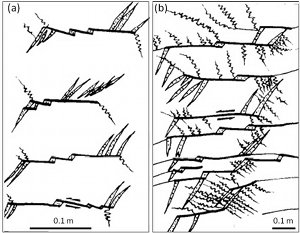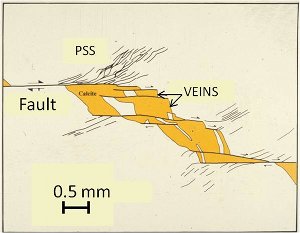| |||||||
|
|
|||||||
|
|
|||||||
| Assemblages of Joints / Veins, Pressure Solution Seams, and Faults | |||||||
|
We have already documented and analyzed the formation of splay joints in response to shearing of a planar structure such as a joint or a bedding plane (see the link to 'Splay Joints'). A somewhat more complex assemblage includes both splay joints (or veins) and splay pressure solution seams associated with a shear fracture (Figure 1). The angles between these different modes of splays in nature show a great variation from 90 to 180 degrees (Rispoli, 1981) as can be seen in the field maps in Figure 2.
Putting it a different way, the absolute angles that these PSS and joint or vein splays make with the extension of the shear fractures, which were referred to as the splay angles in other links in this Knowledgebase, range from teens to nearly 90 degrees. This variation has been interpreted in terms of the presence and size of the cohesive end zone as well as the stress components acting upon the shear fractures (Willemse and Pollard, 1998). The simplest case is associated with a shear fracture with a cohesive end zone, which produces veins and pressure solution seams at right angle to each other at the tip region of the shear fractures. Of course, veins can occur at the extensional quadrants and pressure solution seams at the quadrants of the shear fractures with large compressive stresses as seen in Figure 2 and Figure 3, as well as other maps in 'Faulting by Shearing of Vein and Pressure Solution Seam Assemblages.' Please see the link, 'Mechanisms and Mechanics of Splay Joints' and 'Mechanisms and Mechanics of Splay Pressure Solution Seams.' | |||||||
| Reference: |
|||||||
| Nenna, F., Zhou, X., Aydin, A., 2012 Ohlmacher, G., Aydin, A., 1995 Petit, J.P., Mattauer, M., 1995 Rispoli, R., 1981 Watkinson, A.J., Ward, E.M.G., 2006 |
|||||||
|
Readme | About Us | Acknowledgement | How to Cite | Terms of Use | Ⓒ Rock Fracture Knowledgebase |
|||||||


